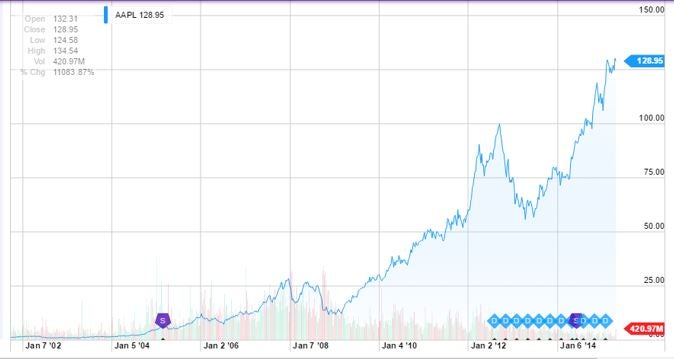I have made the case that AAPL will likely not grow very rapidly over the coming years, not nearly enough to justify buying at these prices. But perhaps the best argument to sell AAPL is due to the more attractive opportunities elsewhere. I have already mentioned FB and GOOGL, both of which trade at lower earnings multiples in spite of materially faster growth rates. But beyond mega-cap tech, the broader tech sector has experienced a crash that has created numerous buying opportunities. Many tech stocks in my coverage are flashing buy signals and appear priced for phenomenal returns. Investors counting on the same reasons driving the rising stock price in the past to work moving forward are likely to be disappointed.
I rate shares a hold but heavily emphasize that better opportunities are elsewhere. Apple Inc currently demonstrates below-average downside deviation. It has Information Ratio of 0.05 and Jensen Alpha of 0.13.
However, we advise investors to further question Apple Inc expected returns to ensure all indicators are consistent with the current outlook about its relatively low value at risk. Understanding different market volatility trends often help investors to time the market. Properly using volatility indicators enable traders to measure Apple's stock risk against market volatility during both bullying and bearish trends.
The higher level of volatility that comes with bear markets can directly impact Apple's stock price while adding stress to investors as they watch their shares' value plummet. This usually forces investors to rebalance their portfolios by buying different stocks as prices fall. Shares of Apple soared after reporting earnings which comfortably beat consensus estimates. There are a lot of reasons to like the stock - growing dividends, share repurchases, and lots of profits. Yet with the stock trading at 28x earnings, I question whether bullish arguments are driven by sentiment or rational thinking. Investors should question why AAPL has invested so much into share repurchases even as the valuation continues to soar.
With the net cash position down to $80 billion versus the current market cap of nearly $3 trillion, the stock faces new challenges as I expect earnings to be volatile exiting this period of peak iPhone sales. This is an incredible time to sell and reallocate in the tech sector. Apple also appears to be getting more Android customers to migrate to its ecosystem, noting that it saw strong double-digit growth in the number of people who switched in Q3.
This is significantly positive, as Apple has done a good job locking in users and better monetizing them with pricier upgrades, new products, and services. While continued revenue growth and solid margin expansion should drive Apple's profits, shareholder returns could be magnified by Apple's massive stock buyback program. For perspective, the company has bought back an average of 5% of its stock each year over the last five years. While earnings are the driving metric behind stock prices, there wouldn't be any earnings to calculate if there weren't any sales to begin with.
Like earnings, a higher growth rate is better than a lower growth rate. Seeing a company's projected sales growth instantly tells you what the outlook is for their products and services. As a point of reference, over the last 10 years, the median sales growth for the stocks in the S&P 500 was 14%. Of course, different industries will have different growth rates that are considered good. So be sure to compare a stock to its industry's growth rate when sizing up stocks from different groups. Rose 34% last year and has pulled back $10 this week from all-time highs due to the tech meltdown.
Expected to give only 2-3% earnings growth, but it usually surprises. Last year it suffered supply chain delays, but that should be a tailwind this year, including China. Services make up 19% of total sales and will grow a lot, and services offer much higher margins than sales. Pays a small dividend, but buys a huge number of shares. Nothing in our research constitutes legal, accounting or tax advice or individually tailored investment advice. Our research is prepared for general circulation and has been prepared without regard to the individual financial circumstances and objectives of persons who receive or obtain access to it.
Our research is based on sources that we believe to be reliable. Some discussions contain forward looking statements which are based on current expectations and differences can be expected. Further, we expressly disclaim any responsibility to update such research. Past performance is not a guarantee of future results, and a loss of original capital may occur. None of the information presented should be construed as an offer to sell or buy any particular security. Some investors seek out stocks with the best percentage price change over the last 52 weeks, expecting that momentum to continue.
Others look for those that have lagged the market, believing those are the ones ripe for the biggest increases to come. Zacks' proprietary data indicates that Apple Inc. is currently rated as a Zacks Rank 1 and we are expecting an above average return from the AAPL shares relative to the market in the next few months. Valuation metrics show that Apple Inc. may be overvalued. Its Value Score of F indicates it would be a bad pick for value investors.
The financial health and growth prospects of AAPL, demonstrate its potential to underperform the market. Recent price changes and earnings estimate revisions indicate this stock lacks momentum and would be a lackluster choice for momentum investors. Cash is vital to a company in order to finance operations, invest in the business, pay expenses, etc. Since cash can't be manipulated like earnings can, it's a preferred metric for analysts. So what are the key trends that are likely to drive Apple's results? While Apple launched its latest iPhone 13 handsets in September, we don't expect the device to be a major driver of Apple's sales, as it was available for sale for just about a week in Q3.
However, it's possible that Apple could be seeing some pressure on device supply, due to the ongoing semiconductor shortage. Apple's margins are also likely to trend higher on a year-over-year basis, driven by a growing mix of services revenues, higher average prices on iPhones, and other devices. See our interactive dashboard analysis onApple Pre-Earningsfor more details.
Yet all of these reasons are backwards looking and speak nothing to what will occur in the future. I find it highly concerning that investors seem to be very enthusiastic about the fact that AAPL is reporting "record numbers," but it is instead the forward growth rate that will drive future returns. The fact that AAPL earned over $123 billion in revenues in the latest quarter is very impressive, but should not be a reason to be buying the stock at 28x forward earnings. At the center of everything we do is a strong commitment to independent research and sharing its profitable discoveries with investors. This dedication to giving investors a trading advantage led to the creation of our proven Zacks Rank stock-rating system.
Since 1988 it has more than doubled the S&P 500 with an average gain of +25.37% per year. These returns cover a period from January 1, 1988 through January 3, 2022. Zacks Rank stock-rating system returns are computed monthly based on the beginning of the month and end of the month Zacks Rank stock prices plus any dividends received during that particular month. A simple, equally-weighted average return of all Zacks Rank stocks is calculated to determine the monthly return. The monthly returns are then compounded to arrive at the annual return.
Only Zacks Rank stocks included in Zacks hypothetical portfolios at the beginning of each month are included in the return calculations. Zacks Ranks stocks can, and often do, change throughout the month. Certain Zacks Rank stocks for which no month-end price was available, pricing information was not collected, or for certain other reasons have been excluded from these return calculations.
Or is there an opportunity to expand the business' product line in the future? If investors know Apple will grow in the future, the company's valuation will be higher. The financial industry is built on trying to define current growth potential and future valuation accurately.
All the valuation information about Apple listed above have to be considered, but the key to understanding future value is determining which factors weigh more heavily than others. The new iPhone 12 handsets saw their first full quarter of sales over Q2 FY'21, helping iPhone revenue rise 65% compared to last year. The iPhone is Apple's most profitable hardware product and the new handset is also priced at a premium compared to its predecessors, helping margins. For example, Apple says that it has about 660 million paid subscriptions on its platform now, marking an increase of 145 million compared to last year.
Separately, Apple said that it also benefited from a favorable foreign exchange environment. If a stock's Q1 estimate revision decreases leading up to its earnings release, that's usually a negative sign, whereas an increase is typically a positive sign. What's more worrying is that Apple's growth could slow down meaningfully this fiscal year.
Analysts are expecting just 4.5% revenue growth in fiscal 2022 to $382.3 billion, while earnings are expected to increase just 2.3% to $5.74 per share. The potential interest rate hikes could add to the gloom and keep Apple from repeating its stellar stock market performance of the past three years. It is the largest company in the world and can still make money. Apple has an attractive valuation and there are still lots of opportunities to sell hardware.
Is Aapl A Buy Sell Or Hold It is also adding more and more services and bundling them. It is a growing part of everyday lives and has increased relevance every day. We track the performance of the top 100 financial experts across various large and mid-size financial boutiques.
Apple analyst recommendations are determined by taking all analyst recommendations and averaging them as Strong Buy, Buy, Hold, Strong Sell or Sell. There is no one specific way to measure analysis performance other than comparing it to the past results via a very sophisticated attribution analysis. Apple is clearly in a much better position to navigate the ongoing headwinds compared to other smartphone players. Apple is the most profitable company in the smartphone space by far, with gross margins standing at a solid 42% in Q4 FY'21. This means the company should be in a better position to pay more to secure supply, compared to smaller players, without really impacting its profits.
This could mean that Apple will see reasonable supply growth despite shortages. Demand should also hold up, as carrier promos for the new devices also appear attractive, as wireless carriers look to sign on customers for their recently built out 5G networks. Stronger momentum in the iPhone business is always a big catalyst for Apple stock, and this could be validated as Apple publishes Q1 FY'22 earnings.
When running Apple Inc price analysis, check to measure Apple's market volatility, profitability, liquidity, solvency, efficiency, growth potential, financial leverage, and other vital indicators. We have many different tools that can be utilized to determine how healthy Apple is operating at the current time. Most of Apple's value examination focuses on studying past and present price action to predict the probability of Apple's future price movements. You can analyze the entity against its peers and financial market as a whole to determine factors that move Apple's price. Additionally, you may evaluate how the addition of Apple to your portfolios can decrease your overall portfolio volatility.
Have you ever been surprised when a price of an equity instrument such as Apple is soaring high without any particular reason? This is usually happening because many institutional investors are aggressively trading Apple Inc backward and forwards among themselves. Apple's institutional investor refers to the entity that pools money to purchase Apple's securities or originate loans. Institutional investors include commercial and private banks, credit unions, insurance companies, pension funds, hedge funds, endowments, and mutual funds.
Operating companies that invest excess capital in these types of assets may also be included in the term and may influence corporate governance by exercising voting rights in their investments. The advice is provided from Apple's buy-and-hold perspective. Please continue to Apple Analyst Recommendation to compare Macroaxis Buy or Sell Recommendation with the current analyst consensus.
To check ratings for multiple equity instruments, please use the Instant Ratings tool. We conduct extensive research on individual companies such as Apple and provide practical buy, sell, or hold advice based on selected investing horizon and risk tolerance towards Apple Inc. Asset allocation, two terms that involve spreading your money across various investments to align how much risk you're taking with your personal risk tolerance. Investing your entire portfolio in any single stock is considered risky; one run of bad luck for that company and your whole investment is at risk. Diversifying your investments across many companies, industries and geographical locations can help reduce that risk.
Should investors really be cheering the incessant share repurchases even as the multiple has expanded above the 25x range? AAPL bulls might argue that the share repurchases are not stopping innovation, but that isn't such an easy argument. Research & development (R&D) stood at $6.3 billion - only 11.6% of gross profits.
In comparison, mega-cap tech peers Meta Platforms and Alphabet spent 27.2% and 20.5%, respectively. Both FB and GOOGL are out-spending AAPL in R&D in spite of producing lesser profits. If one wants that kind of upside, FB or GOOGL make a lot more sense. I note that FB and GOOGL trade at much cheaper valuations relative to their growth rates. The 1 week price change reflects the collective buying and selling sentiment over the short-term. A strong weekly advance is a sought after metric for putting potential momentum stocks onto one's radar.
Others will look for a pullback on the week as a good entry point, assuming the longer-term price changes (4 week, 12 weeks, etc.) are strong. The Momentum Score takes all of this and more into account. A P/B of 1 means it's selling at its per share book value.
A P/B of 2 means it's selling at 2 times its book value. Note; companies will typically sell for more than their book value in much the same way that a company will sell at a multiple of its earnings. The median P/B ratio for stocks in the S&P is just over 3. While a P/B of less than 3 would mean it's trading at a discount to the market, different industries have different median P/B values.






























